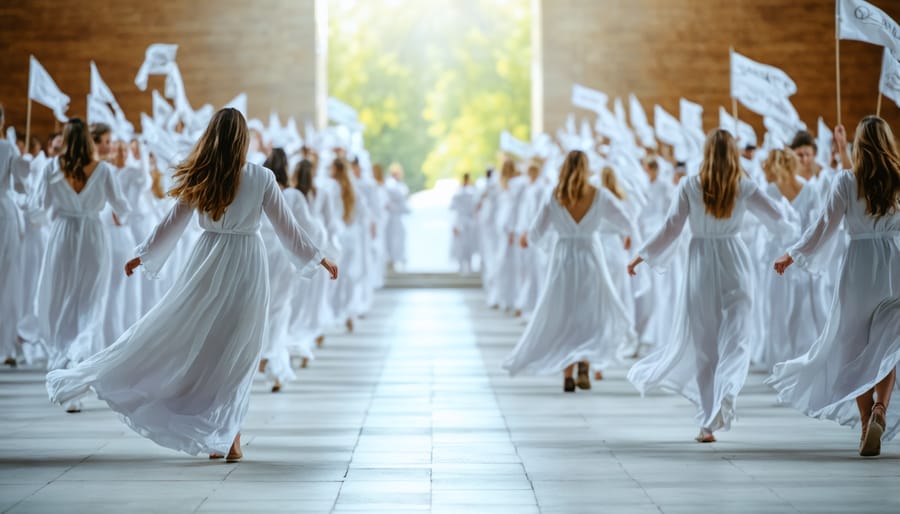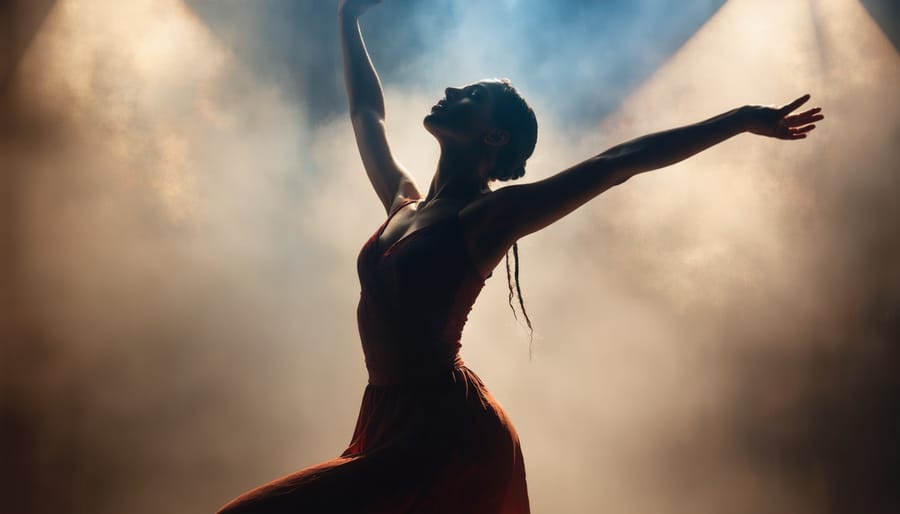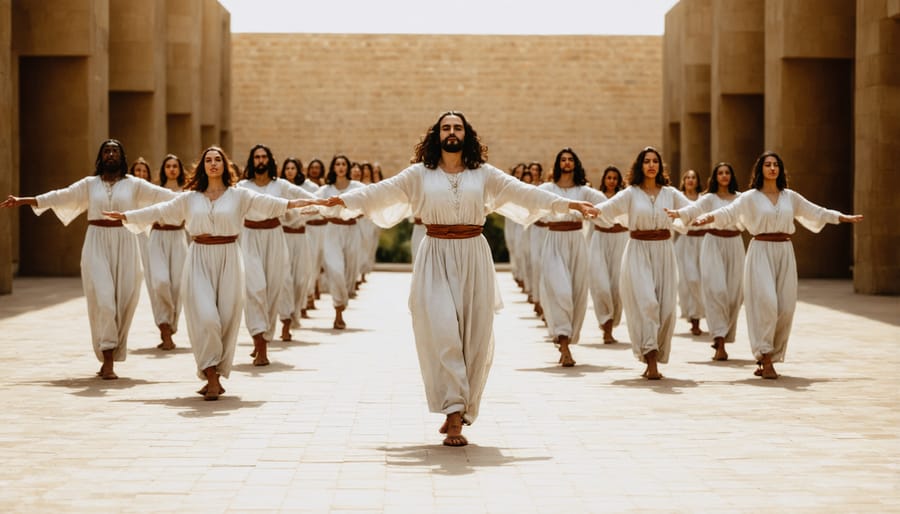Liturgical dance transforms ordinary movement into sacred expression that deepens worship and ministry across Christian traditions worldwide. From the graceful processions of Byzantine worship to the jubilant praise dances of contemporary services, sacred dance has woven itself into the fabric of Christian worship for centuries. These holy movements – whether performed by trained dancers or entire congregations – express everything from solemn reverence to ecstatic joy, creating powerful moments of connection between worshippers and God. Throughout history, different Christian communities have developed their own distinct forms of liturgical dance, each reflecting their unique cultural heritage while remaining rooted in biblical principles of worship through movement. Today’s liturgical dancers draw from this rich treasury of sacred movement, incorporating both ancient traditions and contemporary expressions to bring Scripture to life through the gift of dance.
Processional and Recessional Dance

Movement Patterns and Symbolism
Liturgical dance incorporates meaningful movements that reflect biblical themes and spiritual truths. Raised hands symbolize surrender and praise, while bowing or kneeling represents humility and reverence before God. Circular movements often represent God’s eternal nature and the unity of believers, while forward and backward steps can symbolize the journey of faith or leaving old ways behind.
Many movements draw inspiration directly from Scripture, such as “dancing before the Lord” like David did, or movements that illustrate biblical stories and concepts. The use of flags, banners, and fabric in dance represents God’s attributes – purple for royalty, white for purity, and gold for God’s glory.
Each gesture carries spiritual significance: reaching up represents drawing closer to God, while reaching out symbolizes ministry and evangelism. These movements, when performed with sincere hearts, create a visual prayer that enhances corporate worship and personal devotion.
Musical Accompaniment
Liturgical dance is intimately connected with sacred music, ranging from traditional hymns to contemporary worship songs. Traditional accompaniment often includes classical sacred compositions, Gregorian chants, and organ music, which provide a reverent backdrop for more formal liturgical movements. Many congregations also incorporate modern praise and worship music, allowing dancers to express their faith through contemporary rhythms and melodies.
The choice of music depends on the specific type of dance, the church’s tradition, and the message being conveyed. Some dances are performed to a cappella singing or simple percussion, emphasizing the raw spiritual connection. Others may utilize full worship bands or orchestral arrangements. Scripture-based songs are particularly powerful, as they reinforce the biblical message through both movement and melody.
Musicians and dancers often work together to create a harmonious worship experience that uplift the congregation and glorify God. The key is selecting music that supports the dance’s intention while maintaining its sacred purpose.
Praise Dance
Solo Expressions
Solo expressions in liturgical dance offer individuals a deeply personal way to connect with God through movement. This intimate form of worship allows dancers to portray their individual journey of faith, struggles, victories, and moments of divine revelation through choreographed sequences. Drawing inspiration from Scripture, personal testimony, or spiritual songs, solo dancers often incorporate gestures of supplication, praise, and surrender.
These individual performances frequently take place during special worship services, prayer meetings, or spiritual retreats. Soloists may use various props such as flags, scarves, or ribbons to enhance their expression, though many choose to dance with just their bodies as instruments of praise. The movements can range from gentle, flowing motions that reflect peaceful meditation to dynamic, powerful gestures that embody spiritual warfare or celebration.
Solo liturgical dance requires both technical skill and spiritual preparation. Dancers often spend time in prayer and Bible study to ensure their performance authentically conveys their message while maintaining reverence. This form of worship can be particularly powerful during testimonial services or moments of congregational reflection, creating space for others to encounter God through one person’s devoted expression.

Group Choreography
Group choreography in liturgical dance beautifully illustrates the unity of the Body of Christ through synchronized movement and collective expression. These arrangements typically involve three or more dancers working together to create powerful visual representations of worship themes, scripture passages, or sacred music.
The strength of group choreography lies in its ability to demonstrate community, fellowship, and shared faith. Dancers move in harmony, creating patterns and formations that can represent biblical concepts like the Trinity, the twelve disciples, or the gathering of God’s people. Common elements include circle formations symbolizing God’s endless love, partner work representing spiritual relationships, and synchronized movements depicting unity in the Spirit.
Many congregations incorporate group dance during special services, celebrations, and festivals. These performances often tell biblical stories or interpret worship songs through movement. The choreography may include traditional elements like lifting hands in praise, kneeling in reverence, or moving in processional patterns. Group arrangements provide opportunities for dancers of varying skill levels to participate together, fostering inclusion and community while creating visually stunning expressions of corporate worship.
Interpretive and Prayer Dance
Biblical Storytelling
Biblical storytelling through dance brings Scripture to life by combining graceful movements with narrative elements from God’s Word. This dynamic form of worship, deeply rooted in the heritage of liturgical dance, transforms biblical passages into visual representations that engage both performers and observers in a profound spiritual experience.
Dancers use carefully choreographed movements to portray biblical characters, events, and parables, making the Word of God more accessible and memorable for congregations. Through expressive gestures, facial expressions, and coordinated routines, performers can convey everything from David’s victory dance before the Ark of the Covenant to Mary’s joy at the Annunciation.
This form of worship often incorporates traditional religious symbols, props, and costumes to enhance the storytelling experience. Whether performed by individuals or groups, biblical storytelling through dance helps congregations connect with Scripture on an emotional and spiritual level, creating lasting impressions of God’s truth through movement and artistic expression.

Meditative Movement
Meditative movement in liturgical dance embraces the gentle, contemplative aspects of worship, allowing dancers to experience deep spiritual connection through mindful physical expression. Like the Psalmist who meditated day and night on God’s word, this form of sacred dance combines slow, intentional movements with prayerful reflection.
Practitioners often incorporate breathing exercises and flowing gestures that mirror the cadence of contemplative prayer. Simple, repeated movements help dancers focus their hearts on Scripture, allowing the Holy Spirit to guide their expression. This can include raising hands in surrender, kneeling in reverence, or moving in circular patterns that represent God’s eternal nature.
Meditative movement may be performed individually or in groups, often set to instrumental worship music or conducted in silence. Many find this form particularly meaningful during personal devotional time or quiet moments in corporate worship. The emphasis remains on creating sacred space for intimate communion with God, rather than performance or technical skill.
This gentle approach to liturgical dance makes it accessible to believers of all ages and physical abilities, offering a pathway to embody prayer through movement.
Prophetic Dance
Prophetic dance emerges from a deep connection with the Holy Spirit, where movements flow spontaneously as a physical expression of God’s presence and message. Unlike choreographed performances, this form of worship dance is led by the Spirit in the moment, allowing dancers to respond to divine inspiration with authentic, unrehearsed movements.
Scripture provides numerous examples of spontaneous, Spirit-led expressions of worship, such as David dancing before the Lord with all his might (2 Samuel 6:14). This biblical foundation reminds us that movement can be a powerful vessel for prophecy and spiritual revelation, just as traditional spoken prophecy conveys God’s messages to His people.
In practice, prophetic dance often begins with prayer and spiritual preparation, creating space for the Holy Spirit to guide the dancer’s movements. These expressions may range from gentle, flowing motions to more dynamic gestures, each serving as a physical representation of what the Spirit is speaking to the congregation or individual.
The purpose of prophetic dance extends beyond personal expression to ministry and edification of the body of Christ. As 1 Corinthians 14:3 teaches, prophecy serves to strengthen, encourage, and comfort others. Through Spirit-led movement, dancers may convey biblical truths, spiritual warfare, intercession, or words of encouragement that resonate with observers on a deep spiritual level.
While this form of liturgical dance requires sensitivity to the Holy Spirit’s leading and discernment, it remains accessible to anyone who feels called to express worship through movement. Many churches incorporate opportunities for prophetic dance during worship services, prayer meetings, or special gatherings, recognizing its value in building up the faith community.
Dance in worship represents a powerful and meaningful way to express our devotion to God, following in the footsteps of biblical figures like David, who danced before the Lord with all his might (2 Samuel 6:14). As we’ve explored the various forms of liturgical dance, we can see how this sacred art form continues to enrich worship experiences across different Christian traditions.
Whether through the graceful movements of processional dance, the storytelling elements of interpretive dance, or the vibrant expressions of praise dance, each form offers unique opportunities to glorify God through movement. These sacred dances serve not only as acts of worship but also as powerful tools for building community, sharing the Gospel, and deepening our spiritual connection with our Creator.
We encourage you to consider how you might incorporate liturgical dance into your own worship experience. Remember that dance in worship isn’t about perfect technique or performance – it’s about offering our whole selves to God in praise and thanksgiving. Even if you’ve never danced before, there are many ways to participate, from simple hand movements to full-body expressions of worship.
As you explore liturgical dance, approach it with an open heart and remember the words of Psalm 149:3: “Let them praise His name with dancing.” In doing so, you join a rich tradition of believers who have used movement to express their faith throughout the centuries.
